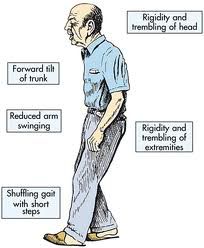It is a degenerative disorder of the basal ganlia function that result in variable combinations of tremor, rigidity and bradykinesia. The disorder is characterized by progressive destruction of the nigrostiatal pathway,with subsequent reduction in striatal concentrations of dopamine.
Predesposing factors:
- lead and carbon monoxide poisoning
- encephalitis
- arteriosclerosis
- hypoxia
- increased dosage of the following drugs: (phenothiazine, haloperidol, reserpine, methyldopa)
Signs and Symptoms:
- pill rolling tremors of extremities especially the hands
- tremor, usually while resting.
- bradykenesia
- rigidity
- over fatigue
- stooped posture
- shuffling and propulsive gait
- mask like facial expression with decreased blinking of the eyes.
- increased salivation
- mood lability
- monotone type speech
- difficulty rising from sitting position
- aotonomic changes (constipation, seborrhea, increased lacrimation, increased sweating, decreased sexual capacity )
Medication:
- Levodopa
- Dopamine agonists
- Apomorphine
- Other drugs (Selegiline, Amantadine)
- Anticholinergics are rarely used in Parkinson's treatment
Note:
- Follow a high-fibre diet as constipation is a common symptom - and can be a side effect of medication.
- Decrease protien in morning and increase protien in afternoon to induce sleep.
- Wait until an hour after eating a large meal before taking a dose of medication, to improve the absorption of the medicine from the digestive system.
- Gentle exercise is important in maximising a patient's general mobility. Regular physiotherapy may help patients exercise effectively as the disease advances.







0 comments:
Post a Comment